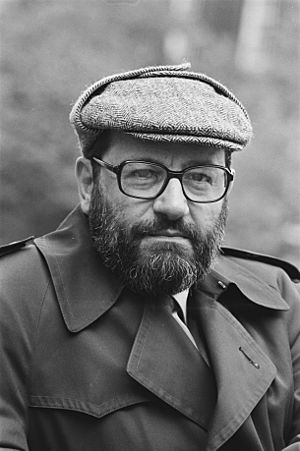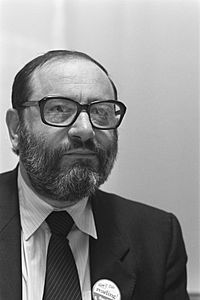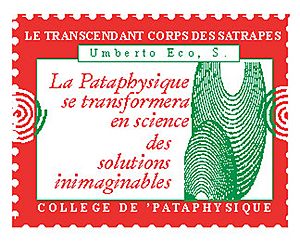Umberto Eco facts for kids
Quick facts for kids
Umberto Eco
|
|
|---|---|

Eco in 1984
|
|
| Born | 5 January 1932 Alessandria, Piedmont, Kingdom of Italy
|
| Died | 19 February 2016 (aged 84) Milan, Lombardy, Italy
|
| Alma mater | University of Turin |
| Spouse(s) |
Renate Ramge
(m. 1962) |
| Era | 20th-/21st-century philosophy |
| Region | Western philosophy |
| School | Continental philosophy |
|
Main interests
|
Semiotics (literary semiotics, film semiotics, comics semiotics) |
|
Notable ideas
|
|
|
Influences
|
|
|
Influenced
|
|
| Signature | |
 |
|
Umberto Eco (January 5, 1932 – February 19, 2016) was a famous Italian writer, philosopher, and expert on signs and symbols (called a semiotician). He was also a medievalist, meaning he studied the Middle Ages.
Eco is best known for his popular novels, especially The Name of the Rose (1980). This book is a historical mystery that mixes detective work with ideas about symbols, medieval history, and how stories are put together. His 1988 novel, Foucault's Pendulum, explores similar themes.
Throughout his life, Eco wrote many books, including ones for children. He also translated books from French and English. For many years, he wrote a newspaper column called "Minerva's Matchbook." At the time of his death, he was a professor at the University of Bologna. He is also recognized for his 1995 essay "Ur-Fascism," where he listed 14 traits of fascist ideas.
Contents
Early Life and Learning
Umberto Eco was born on January 5, 1932, in Alessandria, a city in northern Italy. When he was a child, Italian Fascism was spreading across the country.
During World War II, Umberto and his mother moved to a small village in the mountains. In 1945, his village was freed. He then learned about American comic books, the European Resistance, and the Holocaust. He also had a Salesian education, which is a type of Catholic schooling.
Eco's father wanted him to be a lawyer. But Umberto chose to study at the University of Turin. He wrote his main paper on the ideas of the medieval philosopher Thomas Aquinas. He earned his degree in philosophy in 1954.
His Career and Ideas
After college, Eco worked for the Italian broadcasting station RAI. He produced many cultural shows. In 1956, he became a teacher at his old university.
Exploring Media and Symbols
Eco started to develop his ideas about "open" texts and semiotics. Semiotics is the study of signs and symbols and how they create meaning. In 1962, he published Opera aperta (which means "The Open Work"). In this book, Eco suggested that stories and texts are not just simple messages. Instead, they are like open fields of meaning that readers can explore and interpret in different ways. He believed that texts that let readers think and engage more are the best ones.
From 1965 to 1969, Eco taught about visual communication at the University of Florence. He gave a famous talk called "Towards a Semiological Guerrilla Warfare." This talk introduced the idea of using "guerrilla tactics" against mainstream media. It meant finding clever ways to challenge or change messages from big media companies.
In 1969, he became a professor of semiotics at the Polytechnic University of Milan. Later, in 1971, he moved to the University of Bologna, where he taught for most of his life.
Famous Novels
Eco used his knowledge of the Middle Ages in his first novel, The Name of the Rose (1980). This book is a historical mystery set in a monastery in the 1300s. A friar named William of Baskerville and his helper, Adso, investigate a series of murders. The novel is full of hidden clues and references to other books and ideas. The title itself is a mystery, with a Latin verse at the end suggesting that even great things eventually fade, leaving only their name.
The character William of Baskerville is like a mix of William of Ockham (a real medieval thinker) and Sherlock Holmes. The story also has a library that is like a maze, which reminds readers of a short story by Jorge Luis Borges, a writer who greatly influenced Eco.
The Name of the Rose was later made into a movie starring Sean Connery and Christian Slater. It also became a TV mini-series.
In Foucault's Pendulum (1988), three friends who work at a small publishing house invent a fake conspiracy theory for fun. They call it "The Plan," and it's about a secret group trying to take over the world. But their game becomes dangerous when outsiders believe their made-up plan is real.
Later Works and Ideas
Eco continued to write many books. The Island of the Day Before (1994) is a novel set in the 1600s about a man stuck on a ship near an island. He can't swim, so he spends his time remembering his life.
In 1997, he wrote Kant and the Platypus, a more complex book about semiotics. Eco even joked that it was a "hard-core book" for serious thinkers.
Baudolino (2000) is about a traveler who claims to be a great liar. He tells his life story, from being a peasant boy to being the adopted son of an emperor. The reader is left wondering how much of his story is true.
The Mysterious Flame of Queen Loana (2005) tells the story of an old bookseller who wakes up from a coma with only some memories. He has to choose between his past and his future.
Eco's sixth novel, The Prague Cemetery (2010), is about a secret agent who creates plots and conspiracies. The book explores how antisemitism (hatred towards Jewish people) grew in the 19th century.
In 2012, Eco talked about social media. He famously said that social media gives "legions of idiots the right to speak" when they used to only talk in bars. He felt it gave too much voice to people who didn't have important things to say.
His last novel, Numero Zero (2015), is set in 1992. It makes fun of Italy's culture of bribery and the lasting effects of Fascism.
Influences and Connections
Eco was friends with a group of avant-garde artists and writers called the Neoavanguardia or Gruppo '63. This group was very important to his writing career.
He also helped start Versus, a journal about semiotics. This journal helped semiotics become a recognized field of study in Europe.
Eco's novels are known for having many clever references to other books and historical events. This idea is called intertextuality, meaning all literary works are connected. Eco said that James Joyce and Jorge Luis Borges were the two modern authors who influenced him the most.
He was also a translator, turning French books into Italian.
Awards and Honors
After The Name of the Rose came out in 1980, Eco won the Strega Prize, Italy's top literary award. He received many other awards, including the Mendicis prize and the McLuhan Teleglobe prize. In 2010, he was invited to join the Accademia dei Lincei, a famous Italian academy.
Many universities around the world gave Eco honorary degrees, including the University of Glasgow, Harvard University, and Rutgers University.
Personal Life
In 1962, Umberto Eco married Renate Ramge, a German graphic designer. They had a son and a daughter.
Eco split his time between his apartment in Milan and a vacation house. He had a huge collection of books, with 30,000 volumes in one library and 20,000 in the other!
Umberto Eco passed away at his home in Milan on February 19, 2016, at the age of 84. He had been battling pancreatic cancer.
Images for kids
See Also
 In Spanish: Umberto Eco para niños
In Spanish: Umberto Eco para niños




